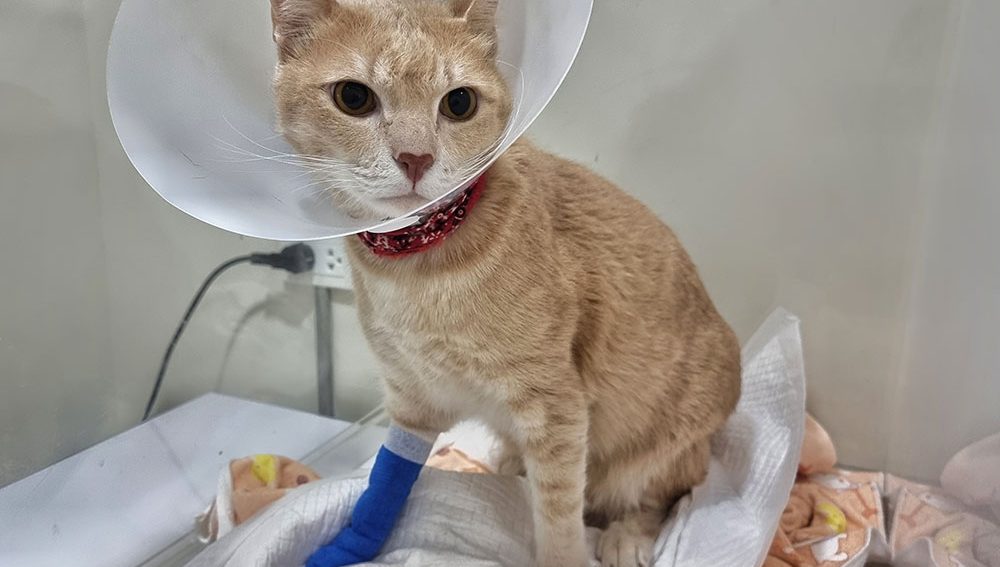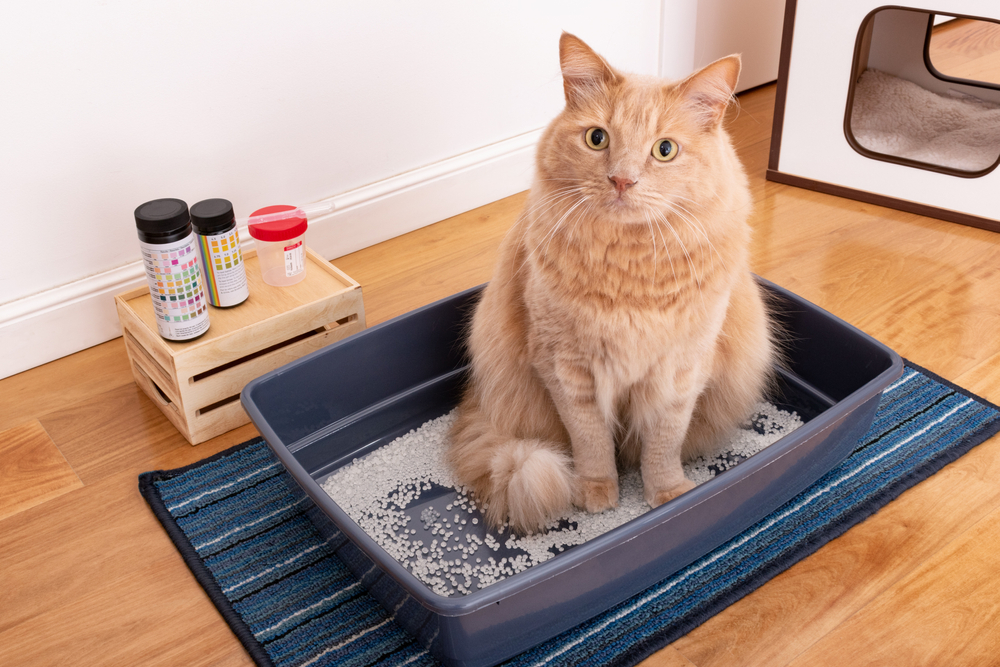
Urinary Blockages in Cats: Symptoms, Causes, and Urgent Care
Can’t Pee, Can’t Wait: What to Do When Your Cat Is Blocked
It’s late at night, and you hear your cat crying in the litter box. They crouch, strain, but nothing comes out. A few minutes later, they return- still uncomfortable, still trying, still unable to urinate. For many cat owners, this moment is terrifying, and for good reason. A urinary blockage is one of the most dangerous emergencies cats can face, especially male cats, and it can turn fatal in as little as a day.
At Harbor Pines Veterinary Center in San Pedro, California, we want you to feel prepared to recognize the early signs, understand what causes blockages, and know how timely veterinary care can save your cat’s life.
Recognizing the Early Warning Signs
Cats are experts at hiding pain, which makes spotting a urinary obstruction even more challenging. Immediate care is critical if your cat shows:
- Frequent but unproductive trips to the litter box
- Straining or crying out while attempting to urinate
- Restlessness, hiding, or sudden aggression due to discomfort
- Vomiting, drooling, or lethargy as toxins build up
- A firm, swollen abdomen that is painful to touch
Because cats rarely “tell” us they’re in pain, tools like the Feline Grimace Scale can help you identify subtle changes in facial expression that point to distress. Some cats may also pace, seek unusual hiding spots, or even vocalize in new, alarming ways.
Why Do Cats Become Blocked?
Blockages are rarely caused by just one factor. They are usually the result of multiple influences acting together.
Idiopathic Cystitis
Stress-related inflammation of the bladder wall (feline idiopathic cystitis) is a leading cause of urinary plugs. Mucus and muscle spasms tighten the urethra, making urine passage impossible. Strategies like enrichment, environmental stability, and consistent routines help reduce recurrence.
Mineral Crystals and Stones
When urine becomes concentrated or imbalanced in pH, struvite or calcium oxalate crystals can form. These may clump into stones that obstruct the urethra. Prescription urinary diets and proper hydration are essential for dissolving crystals and preventing new ones.
Mucus and Cellular Plugs
Inflammatory cells, mucus, and blood sometimes form soft plugs that block the urethra. Catheterization and bladder flushing are required to restore urine flow. Cats who have blocked once are at higher risk of forming plugs again.
Bacterial Infections
While less common in cats, urinary tract infections can cause inflammation and debris that block urine flow. Lab testing ensures infections are treated with the right antibiotics and that resistant bacteria aren’t missed.
How We Diagnose Urinary Blockages
When you bring your cat to Harbor Pines, our veterinarians act quickly:
- Physical exam & vitals – detect bladder distension and overall stability.
- In-house laboratory testing – rapid bloodwork checks kidney function, electrolytes, and toxins.
- Urinalysis – measures pH, crystal type, and infection indicators.
- Imaging – X-rays identify stones, while ultrasound detects bladder wall changes or hidden debris.
These tools allow us to confirm the obstruction, assess its severity, and create a safe treatment plan.
Emergency Treatment: Acting Fast
If a blockage is present, stabilizing your cat is the priority:
- IV Fluid Therapy – restores hydration, corrects electrolyte imbalances, and supports kidneys.
- Pain Management – analgesics ease discomfort and relax the urethra. We may also use laser therapy to reduce inflammation and promote recovery.
- Catheterization & Bladder Flushing – a sterile catheter relieves the blockage, and flushing clears debris.
- Monitoring & Support – hospitalization allows us to track urine output, blood pressure, and electrolytes.
If infection is present, antibiotics are prescribed. Cats remain under close supervision until stable, often with urinary catheters left in place for 24–48 hours to ensure continuous flow.
Surgical Solutions for Repeat Cases
For cats with repeated blockages, a perineal urethrostomy (PU surgery) may be the best long-term solution. This procedure creates a wider opening in the urethra to allow crystals, plugs, or debris to pass more easily.
At Harbor Pines, PU surgeries are performed in our advanced surgical center with continuous monitoring, advanced anesthesia protocols, and attentive pain control. Recovery involves hospitalization, careful incision care, and long-term dietary management. While PU surgery is not a cure-all, it dramatically reduces the risk of obstruction and provides many cats with lasting relief and a return to normal, comfortable lives.
Prevention: Protecting Your Cat’s Future
Preventing blockages is just as important as treating them. Here’s how to lower your cat’s risk:
Hydration
Encourage fluid intake with wet food, multiple bowls, or fountains. Cats who drink more water dilute their urine, making crystal formation less likely.
Routine Wellness Exams
Biannual wellness and vaccination visits allow us to detect crystals, infection, or kidney issues before they become serious. For added convenience, our mobile services bring preventive care right to your doorstep. Cats with a history of blockages may also benefit from periodic urinalysis to catch early signs of recurrence.
Dietary Support
Prescription urinary diets maintain optimal urine pH and mineral balance. They are specially formulated to dissolve some crystals and prevent recurrence. Regular rechecks help ensure the diet is working as intended.
Stress Management
Cats are sensitive to stress. Provide perches, hiding spots, and enrichment toys. Resources like DIY cat toys and the Indoor Pet Initiative offer excellent strategies for reducing anxiety and improving bladder health.
Litter Box Habits
Cats are more likely to hold urine if they dislike their litter box setup. Clean, spacious, and low-entry boxes in quiet areas encourage proper elimination. The Cat Friendly litter box guide outlines best practices to reduce avoidance and stress.
When to Seek Immediate Veterinary Care
Any straining, crying, or refusal to urinate is an emergency. Cats cannot “wait it out” when it comes to blockages. Harbor Pines Veterinary Center accommodates urgent cases during business hours, and we advise seeking a 24-hour facility after hours to prevent fatal complications.

Why Choose Harbor Pines Veterinary Center
At Harbor Pines, we provide more than treatment- we provide partnership. Our AAHA-accredited facility offers in-house labs, at-home care, advanced surgery, and supportive therapies like laser treatment. Every patient receives individualized care, and every owner receives clear communication and guidance.
Helping Your Cat Find Relief
A urinary blockage can be one of the most frightening experiences for a cat owner. If your cat shows any signs of obstruction, call (310) 517-1832 immediately. For preventive care, schedule a wellness exam or request a mobile visit. At Harbor Pines Veterinary Center, we’re here to provide urgent relief, ongoing support, and a healthier future for your feline family member.
